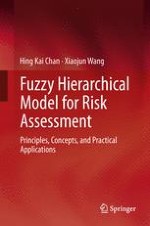2013 | OriginalPaper | Chapter
5. Fuzzy AHP Approach for Analysing Risk Rating of Environmentally Friendly Product Designs
Authors : Hing Kai Chan, Xiaojun Wang
Published in: Fuzzy Hierarchical Model for Risk Assessment
Publisher: Springer London
Activate our intelligent search to find suitable subject content or patents.
Select sections of text to find matching patents with Artificial Intelligence. powered by
Select sections of text to find additional relevant content using AI-assisted search. powered by
